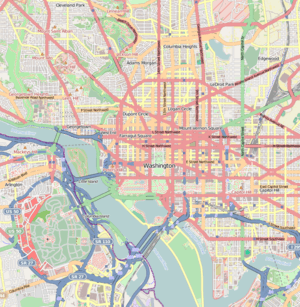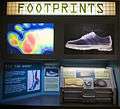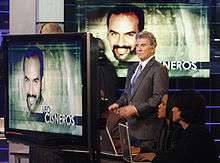National Museum of Crime & Punishment
 Location within Washington, D.C. | |
| Established | May 23, 2008 |
|---|---|
| Dissolved | September 30, 2015 |
| Location |
575 7th Street NW Washington, DC |
| Coordinates | 38°53′49″N 77°01′18″W / 38.897°N 77.0216°W |
| Public transit access |
|
| Website | www.crimemuseum.org |
The National Museum of Crime and Punishment, also known as the Crime Museum, was a privately owned museum dedicated to the history of criminology and penology in the United States.[1][2] It was located in the Penn Quarter neighborhood of Washington, D.C., half a block south of the Gallery Place station. The museum was built by Orlando businessman John Morgan, in partnership with John Walsh, host of America's Most Wanted, at a cost of $21 million, and opened in May 2008.[2] Unlike most museums in Washington, DC, the Crime Museum was a for-profit enterprise.[3] It was forced to close in September 2015 by its building's owners after it failed to meet sales targets specified in its lease.[4]
More than 700 artifacts in 28,000 square feet (2,600 m2) of exhibition space related the history of crime, and its consequences, in America and American popular culture.[5][6] The museum featured exhibits on colonial crime, pirates, Wild West outlaws, gangsters, the Mob, mass murderers, and white collar criminals. Twenty-eight interactive stations included the high-speed police chase simulators used in the training of law enforcement officers, and a Firearms Training Simulator (F.A.T.S.) similar to that utilized by the FBI.[7]
The galleries
The main floor was devoted to a staged crime scene investigation of a simulated murder. Visitors to the museum were guided through the process of solving the crime through forensic science techniques, including ballistics, blood analysis, finger printing and foot printing, and dental and facial reconstruction.[8]
The museum included a mock police station with a booking room, celebrity mug shots, police line-up, lie detector test, prisoners' art and self-created devices for injury and escape, and a re-creation of the jail cell of Al Capone at the Eastern State Penitentiary in Philadelphia. A capital punishment room offered a re-creation of a guillotine and gas chamber, along with an authentic lethal injection machine from the state prison in Smyrna, Delaware, and an electric chair from the Tennessee State Prison in Nashville which was used for 125 executions.[9]
The crime-fighting gallery drew attention to such notables as founding FBI Director J. Edgar Hoover, and the legendary law enforcement agent Eliot Ness. It also included the uniforms, firearms, and restraining equipment of law enforcement officers, as well as exhibits on bomb squad and night vision technologies.
America's Most Wanted studio
At one time the museum served as the television studio for America's Most Wanted, a long-running (1988–2013) television series that dramatized unsolved crimes. The television program led to the capture of more than 1,000 fugitives (16 from the FBI Ten Most Wanted Fugitives) due to the crime tips reported by the public when criminals were profiled.[10] When the series switched to on-location shooting, the studio was converted into an interactive exhibit where visitors could solve a hypothetical crime. Surrounding the studio were exhibits on the National Center for Missing and Exploited Children and McGruff the Crime Dog, as well as a Cross Match Technologies station for child finger printing.
Highlighted Attractions
CSI Lab: Enter a crime scene and interact to solve the case in a real crime scene lab
FBI Agent Training: Practice your aim in a simulated FBI shooting range
High Speed Police Simulator: Drive in a police academy training pursuit
Authentic Artifacts: Auxiliary, electric chair, gas chamber, prison art, and jail cells
Notorious Criminals: Legendary pirates, the mob, Wild West outlaws, and serial killers
Digital Fingerprinting for Children With Printout ID Cards
America's Most Wanted Stage Set and John Walsh Interactive
Crime Museum Mission
The mission was to provide guests of all ages with a memorable insight into our Nation's history of crime and its consequences, law enforcement, forensic science, crime scene investigation (CSI) through a captivating interactive, entertaining and educational experience.
Gallery
 Pirates Gallery
Pirates Gallery Wild West Shooting Gallery
Wild West Shooting Gallery Bonnie and Clyde Death Car
Bonnie and Clyde Death Car Mob Gallery
Mob Gallery Serial Killers Gallery
Serial Killers Gallery America's Most Wanted Television Studio
America's Most Wanted Television Studio Crime and the Media Gallery
Crime and the Media Gallery Mock crime scene
Mock crime scene CSI footprints
CSI footprints CSI Reconstruction Techniques
CSI Reconstruction Techniques The CSI Experience
The CSI Experience An electric chair
An electric chair Harley Davidson police motorcycle
Harley Davidson police motorcycle A jail cell
A jail cell Staircase in the museum
Staircase in the museum John Walsh filming a segment for America's Most Wanted
John Walsh filming a segment for America's Most Wanted
References
- ↑ Wire, Sarah D. (May 16, 2008). "Crime Museum opening in D.C.". Los Angeles Times.
- 1 2 Cooper, Rachel. "Crime Museum in Washington, DC". about.com. Retrieved 2008-06-25.
- ↑ Arroyo, Leah. "Sex, Drugs and Pirates: The rise of the for-profit museum". American Association of Museums. Retrieved 2010-02-23.
- ↑ Stein, P. (August 31, 2015). Crime museum is closing at the end of September. Washington Post archive, retrieved February 22, 2016.
- ↑ Trescott, Jacqueline (May 23, 2008). "Some People Would Die To Wind Up at This Museum". Washington Post.
- ↑ Hemmerdinger, Jonathan (June 5, 2008). "Where crime is considered history". The National.
- ↑ Wire, Sarah D. (July 13, 2008). "Law enforcement takes spotlight at D.C. museum". Los Angeles Times.
- ↑ McKay, Gretchen (July 6, 2008). "Crime, punishment court travelers to D.C. museum". Pittsburgh Post-Gazette.
- ↑ Dietsch, Deborah K. (May 23, 2008). "Crime pays at new museum". Washington Post.
- ↑ Keveney, Bill (May 19, 2008). "'America's Most Wanted' hits a milestone". USA Today.
External links
| Wikimedia Commons has media related to National Museum of Crime and Punishment. |
Coordinates: 38°53′49″N 77°01′18″W / 38.897°N 77.0216°W